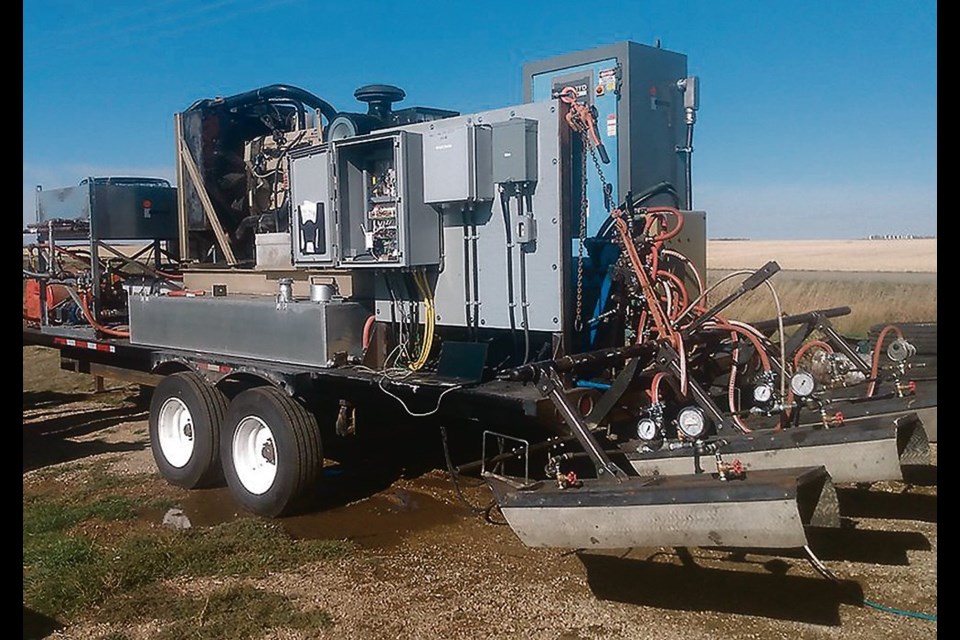One of the more promising innovations is currently being developed by Chaplin, Sask., farmer Ron Gleim, whose X-Steam-inator has progressed well beyond the experimental stage.
The pull-type steam machine douses weeds with a maximum stream of 150 C steam under 50 pounds per sq. inch of pressure. Gleim says field trials have shown it to be nearly 100 percent successful in cooking every type of weed, including Canada thistle and quack grass.
“We know the X-Steam-inator kills pretty well every plant it touches, depending on how fast we go,” Gleim said, adding that his team tried a wide variety of heat and pressure combinations and has built a programmable logistics system to quickly change those variables.
“We originally thought we needed about 150 C, but after some trials we found we could do just as good a job with 130 C using a little more saturation. We tried pressures up to 50 p.s.i. and got really good results with that, but then we also had good results all the way down to 20 p.s.i. Desiccation requires higher pressures. We’ve desiccated potatoes and that worked very well.
“We’ve done quite a bit of work on Canada thistle. We fried them pretty good when they were about seven inches tall in August. That kill lasted until freeze-up. You have to keep in mind that more heat and more pressure always consumes more diesel energy.”
Gleim says he is concentrating on high-value crops such as potatoes and beans for now. He can do desiccation plus between-row and in-row steam application in those crops. He’s taking this approach simply because table-ready high-value foods are under the most pressure to eliminate chemicals, and this sector has the cash flow to invest in emerging technology. The clothing industry, too, is under pressure to eliminate agricultural chemicals from fabrics.
“We don’t grow a lot of cotton here in Saskatchewan, but they have about 15 million acres down in the States. They have to get their chemicals out of cotton fabrics just like food producers have to get rid of chemicals. So, we’re doing some work with cotton growers, too.”
Gleim was recently contacted by a California vegetable grower who was running eight propane desiccation machines. The burners shoot intense flame directly down on the foliage, thus killing the plants. The 16-foot wide implements burn 100 gallons of propane per hour. With 500 gallon tanks, they’re able to work for only five hours before re-filling the propane tanks. They run four tank loads per machine, for a total of 20 hours per day, covering 3.6 acres per hour. It’s a pretty tedious expensive operation.
“We tried our machine in a couple places and got a good kill. It’s working well enough that we’re taking it down to Yuma, Arizona, for three months this winter to do a bunch of in-row, row-cropping, desiccation and pre-seeding work. Right now, we’re getting some farmers lined up for demonstrations. We gain a whole summer this way. The California guy said there are probably a few hundred of these flame throwers scattered around the continent.
“We have three prototypes. The bigger one is four rows. We think we can go up to eight rows. We’ll be able to do 16 to 20 feet quite easily. The vegetable growers say all they need is 16 feet to make it worthwhile. We’ll get up to 22 feet for in-row on potatoes for desiccation.”
One prototype was built by Honey Bee in Frontier, Sask., that can carry a 75 kilowatt unit or a 150 kW unit. He now has one of each size.
Gleim’s company also have a small 20 kW unit for vineyards. He plans to take the 20 kW and the 150 kW south for testing this winter.
Gleim has concerns about potential damage to beneficial microbes, insects and worms and has delved into a number of studies from Europe that address those issues. The consensus is that it’s not a concern.
“Even the guys that burn down four inches into the soil to get control for four months find that the bugs and microbes are back to their normal level within six weeks. Everything we do, such as fertilizer, for instance, does some damage to soil-bound forms of life. I think our equipment does less harm.”
When the X-Steam-inator is ready to come to market, Gleim expects prices to be in the range of $300,000 to $350,000. The company says it already has a distribution network.

